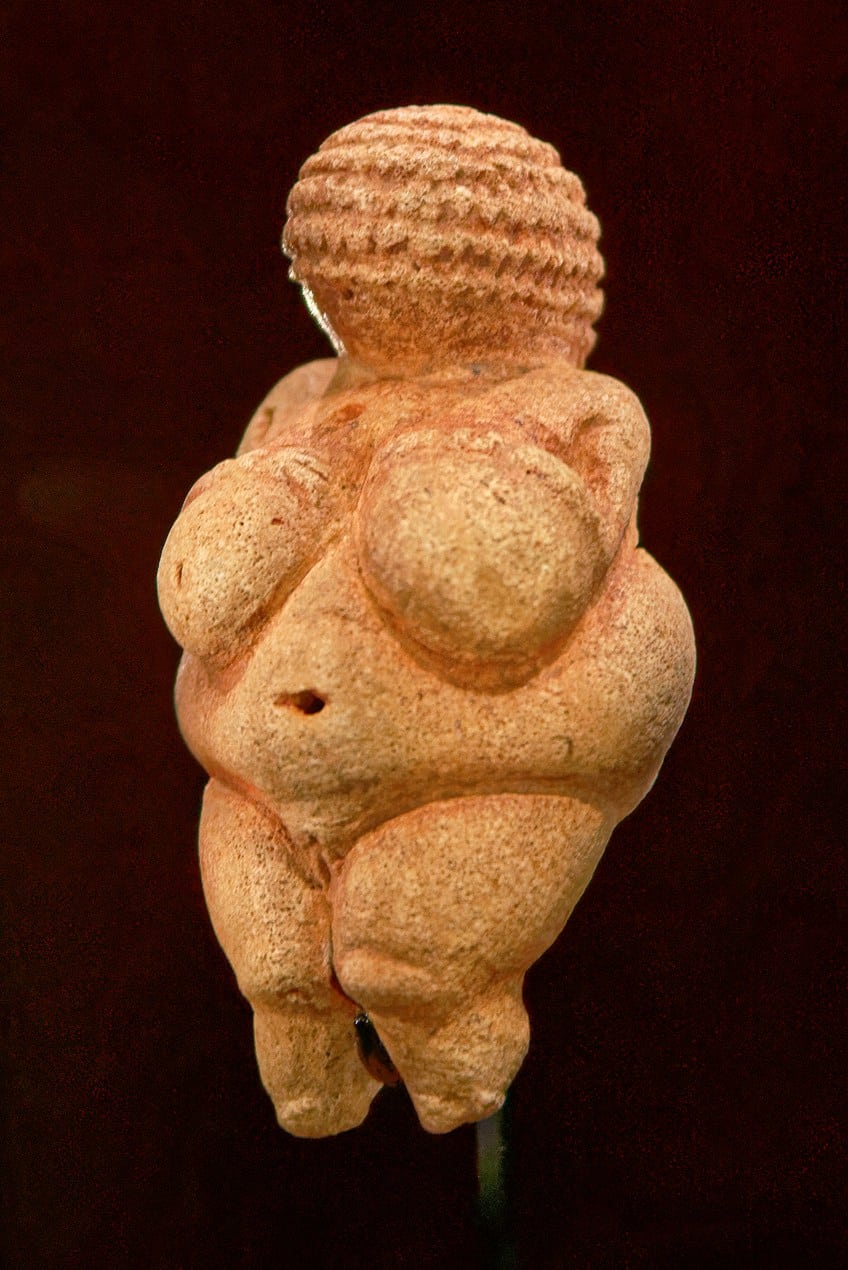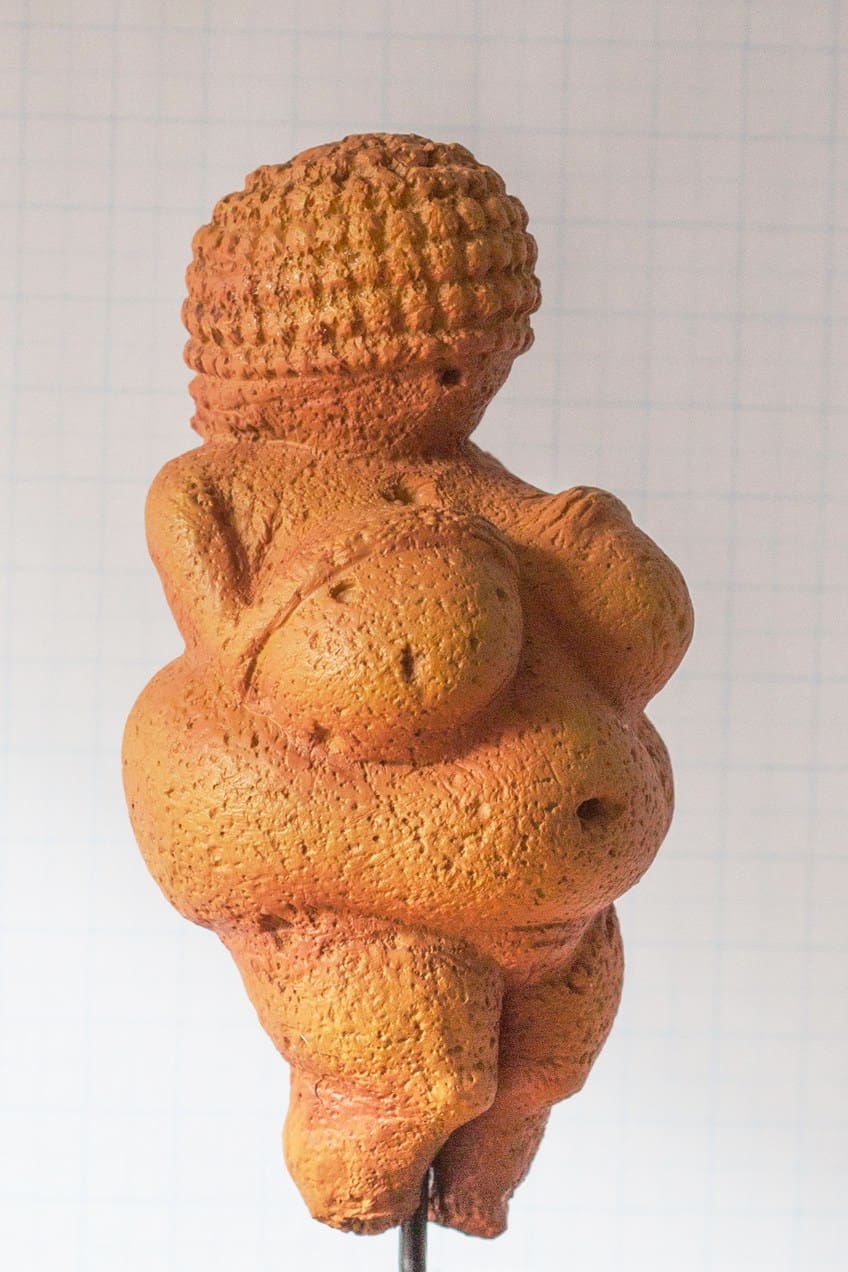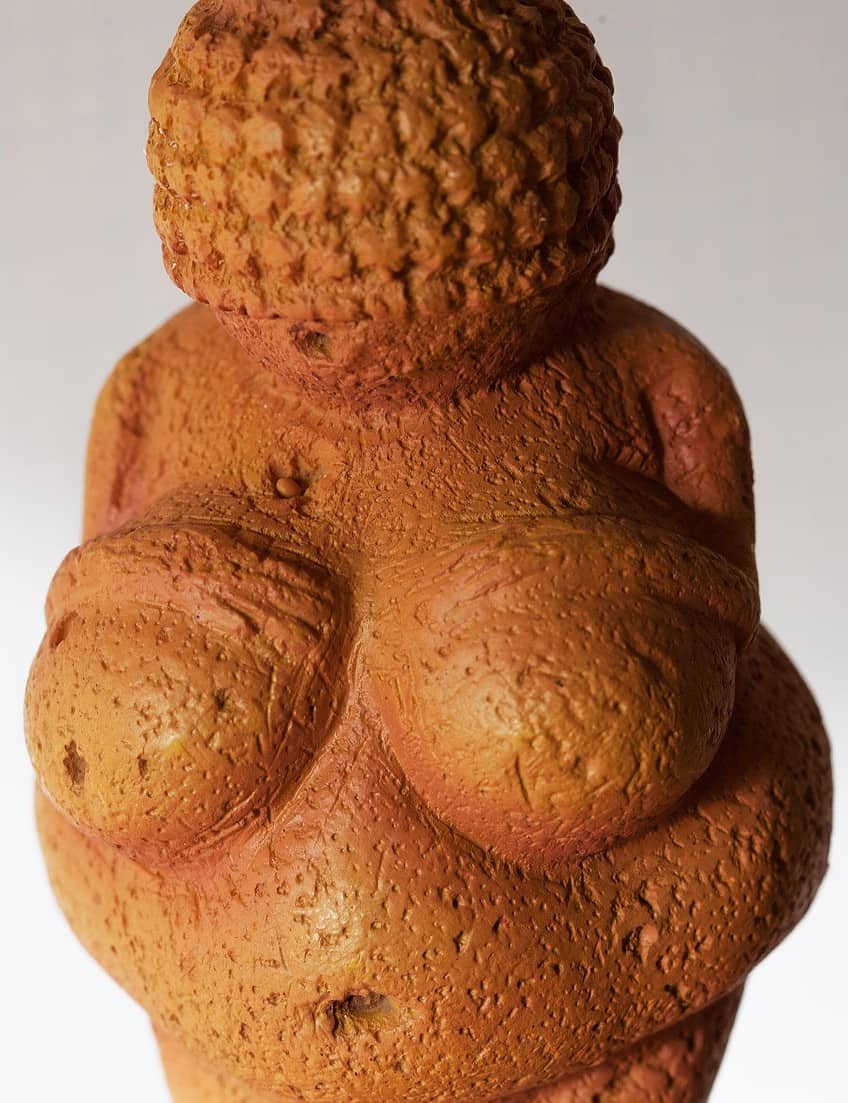“Venus of Willendorf” – The Famous Prehistoric Art Sculpture
Today, we will answer the question: “What is believed to be the purpose of the woman from Willendorf?” The sculpture of a Neolithic woman is an example of prehistoric art and is considered to be a fertility goddess statue. In this article, we will explore the various interpretations of this famous Paleolithic artwork, as well as provide an in-depth Venus of Willendorf analysis.
Contents
The Venus of Willendorf: The Ancient Fertility Goddess Statue
| Artist | Unknown |
| Date | c. 30 000 BCE |
| Medium | Limestone, ochre |
| Location | Willendorf, Austria |
This sculpture of a Neolithic woman is one of the oldest man-made representations of the human body. It was unearthed on the riverbanks of the Danube River and is believed to have been carved by one of the hunter-gatherers that once inhabited the region. This prehistoric artwork was made at a time when the earth had just come out of an ice age, and the terrain and climate at that time would have been bitterly cold and bleak.
This icy climate could be the reason that Paleolithic artists portrayed their females so curvaceously.

In such incredibly intense conditions, any features that highlighted an individual’s capacity to breed were seen as desirable, such as the ability to sustain healthy body weight and therefore reproduce sufficiently. Therefore, in their Prehistoric artworks, the people of that era exaggerated those parts of a Neolithic woman’s body that most symbolized fertility and reproduction – the pelvic girdle and the breasts.
Discovery of the Venus of Willendorf
The village of Willendorf is located near the wine-growing town of Aggsbach in the Lower Austrian region. By the time the anthropologic curator of Vienna’s Natural History Museum, Josef Szombathy, and two young assistants started excavating in the area in 1908, it had already been a Paleolithic site for more than 20 years.
Local enthusiasts had already been digging around the site for many years, but when the owner of a local brickyard found flint tools in the 1870s, proper excavations were conducted.

Several more excavations would take place right up until 1905, revealing human skeletons buried in clay pits from the prehistoric era. In 1908, seven various layers of the Paleolithic period could suddenly be observed when a railroad was laid down that cut deep into the terrain of Willendorf.
Szombathy and his assistants saw this as the perfect opportunity to analyze the layers to gain a better understanding of Central Europe’s cultural development during the Upper Paleolithic period.
The diggers were busy excavating a layer on the 7th of August in 1908, when one of the diggers, Johann Veran, found the little limestone sculpture. George Grant MacCurdy was an anthropologist from Yale that was touring Vienna that year, and he would be the first to write about the sculpture in one of his reports.
The Origins of the Venus of Willendorf
The fertility goddess statue has long been a subject of wonder and mystery. We now know, according to researchers from the University of Vienna, that the stone used to create the figure came from more than 350 miles away from where it was discovered, tracing its origin to Northern Italy. The figurine is an excellent example of portable art: artifacts crafted from ivory, stone, and animal bone that would have been easily transportable for nomadic people throughout the Paleolithic period.
The figure was long thought to have originated outside of Austria since it is constructed of oolitic limestone, a stone that does not occur in or around Willendorf.
This distinguishes it from other fertility goddess statues in that it is the only example ever found made from this stone. The researchers were able to get high-resolution photos of the figure using CT scanning. The limestone was not uniform inside, which assisted their search for the statue’s origin. The stone was packed with a sequence of layers of varying densities, with fragments of baked-in shell, the researchers discovered.

Given the indications provided by the shells, they expanded their search range – from Eastern Ukraine to France, and from Sicily to Germany. They examined samples from throughout Europe for the figurine and Northern Italy turned out to be the best match. This discovery is noteworthy because it sheds light on the migratory habits and patterns of individuals who built and safeguarded the prehistoric artwork.
These hunter-gatherers were among Europe’s first modern people, roaming around the countryside in search of animals and waterways.
Curious as to how the Venus would have arrived in Lower Austria, the researchers explored several routes and discovered one that would have been particularly apparent – an approximately 600-mile trip that would have involved crossing the Danube. They assume that the figurine was looked after through numerous generations and that the journey took place over several lifetimes, implying that the talisman was valued. The CT images provided by the researchers also shed light on another mystery surrounding the figure: why are there hemispherical holes dotting the figurine’s surface?

Some limonites must have broken off and left holes when the figure was being sculpted. The sculptor most likely took advantage of this when a piece fell out of the belly area. While the researchers state in their report that the similarity between the Venus’ rock and the northern Italy sample is nearly identical and shows that the material came from south of the Alps, they also consider the possibility that the statue came from eastern Ukraine.
A Venus of Willendorf Description
The woman from Willendorf is made from which medium? The Prehistoric art figurine is made from limestone and painted with red ochre. The short-statured figure features pronounced breasts, buttocks, and a large belly. It is said to resemble what would be classified as an obese woman in today’s world.
However, this would have been an ideal figure 30,000 years ago.

One cannot discern any facial features at all and a braid-like pattern covers most of the head. The vulva and navel are defined and there are no feet. It is not a large carving, being only four centimeters wide and 11 centimeters in height.
Interpretations of the Venus of Willendorf
Because they were produced before the development of writing and are typically discovered with very little cultural context, the Venus of Willendorf analysis has varied greatly throughout history. According to some scholars, they symbolize everything from self-portraits of women to prehistoric erotica. However, many of these interpretations have subsequently been rejected due to their inherent racism or sexism.
In some respects, the interpretations represent the mindset of the period in which they were discovered more than the Neolithic Period people who initially crafted them.
Traditional Interpretations
Not much is known about its history, manner of production, or cultural relevance; nevertheless, it is one of several Paleolithic Venus sculptures that have survived. Archeologists have presented several interpretations of its relevance for the nomadic tribe that created it. The carving’s function has sparked much debate. It, like many miniatures, lacks feet and cannot stand by itself, however, it may have been anchored into soft ground.
Experts suggest that the Venus of Willendorf was regarded as a fertility goddess statue because aspects of her anatomy connected with pregnancy and childbearing were exaggerated.

The sculpture has an oversized belly and breasts, its pubic area is greatly accentuated, most likely representing reproduction, and the red ochre color coating has been suggested to signify or function as menstrual blood, which is regarded as a life-giving element. The second theory is that the figure worked as a talisman.
Its small size led archaeologists to believe that it was kept by the males on their hunting trips, where it acted as both a memento of their partner back at home and a talisman to bring them luck.
Arguments Against the Traditional Interpretations
When the first of these figures were unearthed in the late 1800s and early 1900s, times were significantly different. The study of anthropology, like many other fields, was occupied almost completely by white men, and many perceptions of ancient societies exhibit this prejudice. The Venus Impudique, the first figurine ever unearthed, translated means “immodest Venus,” implying that the figurine was titled to juxtapose a type of Roman sculpture known as Venus Pudique, which portrays a naked deity of love hiding her genital area with her hands.
The prevalent notion was that Venus sculptures were created by males.

This idea influenced the multiple interpretations of what these sculptures would represent for the people believed to have sculpted them. Early interpretations were categorically prejudiced. For example, some researchers believe that the fat Venus sculptures depicted non-European females, whereas the slender sculptures represented European females.
New Interpretations of the Venus of Willendorf
Regarding the Venus of Willendorf analysis, the times gradually changed, and anthropological analysis caught up. By the 1990s, Catherine McCoid had written a significant research paper called Toward Decolonizing Gender, which studied these figures from a female perspective. This paper was published when a new wave of feminist ideals emerged, influencing anthropological interpretations. We live in a culture that has traditionally been ruled by men, yet anthropology has evolved drastically, especially in the last several decades, and our awareness is continuously growing.
Although Europeans dwelt in a more chauvinistic culture in the not-too-distant past, it doesn’t prove that the same was true in the Stone Age.
Those individuals lived in genuinely impartial communities. They were hunter-gatherers in a collaborative and sharing culture where women were treated equally. While male archaeologists throughout the last 200 years may have concluded that these sculptures were produced by males looking at females, some researchers believe the design of several of the sculptures indicates they were possibly self-portraits of the women who created them.

Due to the absence of mirrors at the time, a woman sculpting her figure would be staring down at her physique, producing accentuated breasts and stomachs and smaller lower legs. When a person views themselves from that angle, the perspective would match the one seen in the sculpture. The figurines might have been designed to aid women in teaching one another.
Archaeologists have discovered only a few surviving figurines, but it’s probable that many more originally existed and were employed by women to convey the distinct phases of pregnancy and delivery.
A woman was assisting another woman in understanding what could occur and what to expect, it had nothing to do with male perceptions at all, according to these researchers. While these sorts of Stone Age images are well-known as Venus figurines, academics aim to replace the label with something less loaded with old thought patterns.
Use as a Talisman
Others argue that, while Catherine McCoid’s interpretation was novel and innovative at the time, it was also influenced by the feminist movement of the era. All European Paleolithic academics believe that the miniatures are representations of something. We won’t locate that “something” if we keep thinking back and inserting modern values and politics into Paleolithic art though.
Some researchers choose to travel further back into our species’ past to analyze the meaning of these feminine portrayals.

When individuals are scared, intimidated, or frightened, they may feel sexual arousal characteristics such as erections. Some researchers assert that early humans must have identified the fear reaction with specific physical characteristics – and that Venus miniatures reflect this. They had their anxieties, they were aware of what was going on in their bodies, and being capable of experiencing fear is therefore highly adaptive. Without it, the survival of the species into the present era would have been quite unlikely.
The great apes, our closest living relatives, appear to be cognizant of this fact as well. Great apes frequently communicate by stroking one other’s organs, according to primatologists.
These behaviors might provide reassurance or establish a social hierarchy system. However, when stimulated, a rush of adrenaline provides apes and humans with a momentary surge in strength. This spike of energy in humans is occasionally coupled with excitation in our sexual organs. Displaying these organs might act as a warning message or a deterrent to other primates.

Stone Age individuals may have just gone the additional mile and transferred a perception of power into a tangible object, such as a protective talisman they wore or utilized in ceremonies. Some may have been stored in homes near a window or the hearth. These female depictions in Stone Age humans may have indicated the same sort of power as phallic representations, which are frequently reflected in cave paintings and other prehistoric artworks. Individuals in the Paleolithic period observed this physical reaction and regarded it as a protective response against unpleasant occurrences.
Since its discovery, this famous representation of a Neolithic woman has sparked the imaginations of thousands of people, creating more questions than it did answers. Was it a fertility goddess statue or something else? Was it created by a man for men or perhaps by a woman for women? It depends on who and when you ask. What we do know is that it was valued enough to be cared for and carried by a multitude of successive generations who regarded it very highly. What we can say for sure is that perceptions of what beauty means from one era to another have changed dramatically. In an age of super skinny models, it can seem like an excessively overweight physique, but for the people of that era, it signified the potential for reproduction and a sign of good health. Or as others believe, it could have been made to teach women about their own bodies and cycles.
Frequently Asked Questions
What Is Believed to Be the Purpose of the Woman From Willendorf?
There are several potential answers to this question depending on who you ask. There is the traditional view that the figurine was created by men as a way to convey their appreciation of the feminine form by accentuating those aspects that were related to childbearing. In this particular view, it was created by men for the enjoyment of other men. There is a more modern view that asserts that it is possible that the figurines could have been created by women to educate the younger females about their bodies. It has been noted that there were no mirrors in the Paleolithic period and that if a woman were to look down at her own body, she would see it from a certain perspective where the breasts would be larger as they are nearer to the eyes, and the legs would be smaller as they were further away. There is also the possibility that they were used as a talisman to release energy through sexual stimulation or as charms to bring good luck to the hunters.
The Woman From Willendorf Is Made From Which Medium?
The little figurine was made from oolite limestone. What is interesting about the stone is that it appears to come from another region completely. Although it has not been determined exactly which region it came from, there are suggestions that it was most likely from somewhere in Northern Italy. There are also a few other candidates though, such as Sicily, Germany, and Eastern Ukraine.
Jordan Anthony is a Cape Town-based film photographer, curator, and arts writer. She holds a Bachelor of Art in Fine Arts from the University of the Witwatersrand, Johannesburg, where she explored themes like healing, identity, dreams, and intuitive creation in her Contemporary art practice. Jordan has collaborated with various local art institutions, including the KZNSA Gallery in Durban, the Turbine Art Fair, and the Wits Art Museum. Her photography focuses on abstract color manipulations, portraiture, candid shots, and urban landscapes. She’s intrigued by philosophy, memory, and esotericism, drawing inspiration from Surrealism, Fluxus, and ancient civilizations, as well as childhood influences and found objects. Jordan is working for artfilemagazine since 2022 and writes blog posts about art history and photography.
Learn more about Jordan Anthony and about us.
Cite this Article
Jordan, Anthony, ““Venus of Willendorf” – The Famous Prehistoric Art Sculpture.” artfilemagazine – Your Online Art Source. September 26, 2022. URL: https://artfilemagazine.com/venus-of-willendorf/
Anthony, J. (2022, 26 September). “Venus of Willendorf” – The Famous Prehistoric Art Sculpture. artfilemagazine – Your Online Art Source. https://artfilemagazine.com/venus-of-willendorf/
Anthony, Jordan. ““Venus of Willendorf” – The Famous Prehistoric Art Sculpture.” artfilemagazine – Your Online Art Source, September 26, 2022. https://artfilemagazine.com/venus-of-willendorf/.



